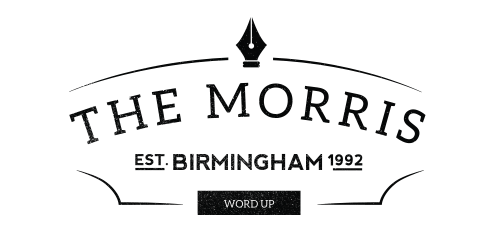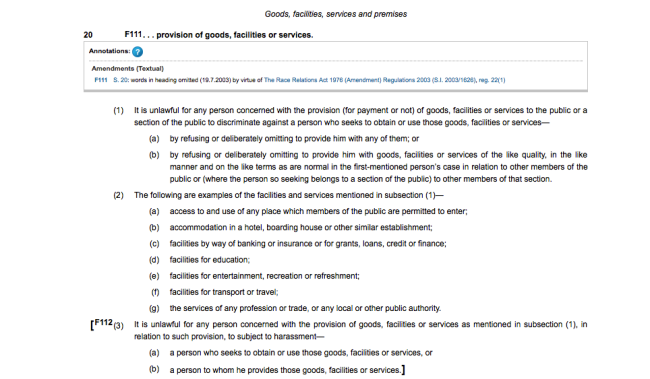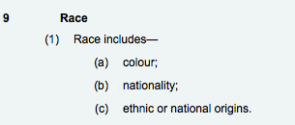This blog comes as a follow-up to one I posted a few days ago exposing a certain degree of race discrimination in Birmingham (to be dissociated with racism). As you may or may not know, I’m a Law student, and whilst I haven’t studied Criminal Law as yet (French Law took over!) that doesn’t mean I can’t try and offer up some advice based on research I’ve done at home. So to be clear, this post won’t be in my usual editorial style, but a more informative one for people that are really interested in the legal issues and potential solutions of race discrimination. I’ll be focussing on relevant legislation, case law and other useful articles.
Firstly, what is racial discrimination?
Like I said, it’s something to be dissociated, at least in part, with racism. According to the Race Relations Act 1976:

In layman’s terms, subsection (1)(a) tells us that racial discrimination is treating a person in a different and importantly worse manner than you would treat another. So in the case of our nightclub scenario, being denied access to a service (in legal terms, running a nightclub is offering up a service to the public) on the grounds that you are of one particular race or another would most certainly come under the terms of the 1976 Act. This is known as ‘direct discrimination’. Subsection (1)(b) covers the hypothesis of ‘indirect discrimination’ where a policy or procedure is applied to everybody, but its application means that people of one race are at a disadvantage.
The said Act focuses for the most part on race discrimination in the work environment; that is, being laid off or treated differently in your employment on the grounds of your racial origins. There is however a smaller Section that can be applied to our particular scenario – the provision of services – that looks like this:
This Section of the Act is pretty easy to follow. The nightclub scenario would fall under subsection (2)(e) in this case, as it’s classed as providing an entertainment service.
Subsection (3) also points out that it’s unlawful for a person to harass another in the context of race discrimination. The Equality Act 2010 clarifies what that means:
The “relevant protected characteristic[s]” for the purposes of the Act are laid out in Chapter 1, and race features in subsection 9:
Harassment can include many things, and even goes so far as to cover a landlord shutting off their tenant’s water supply. However I’m also certain that in some of the situations I was told about, the Equality Act could also be applied in the context of harassment, in particular if you are intentionally humiliated or intimidated by members of security.
So we’ve determined that being turned away from a nightclub because of your ethnicity is something that the law regulates. The important thing to establish is what solutions does the law provide?
As you may or may not know, the UK is a common law system. That means that although we have many pieces of legislation such as the Race Relations Act that provide the basis for the way that the law works, it’s also down to judges to set what are known as precedents. A precedent allows for us to draw similitudes between cases, and “prevents the legal apparatus from becoming clogged by a myriad of single instances“. It’s therefore important for lawyers to be able to check the case law on a given matter, which we do via the use of legal databases and law journals, so that we can try and assimilate the problem in hand with a precedent and predict (or manipulate) the outcome.
I said in my very first post on this subject that I’d tried to look at the case law, but unfortunately I could only find precedents regarding employment in this context on legal databases such as Westlaw. I did however find some interesting BBC articles, as well as some foreign articles. But given that legal systems differ from country to country and that judges are not bound to apply the law of any country except for their own (and EU/international conventions) I’ll only be looking at the articles that focused on the UK.
The most useful case I could find took place in Scotland, and concerned a nightclub called Archaos. If you like, you can read the BBC report here.
In this instance, the evidence against the nightclub’s boss was interestingly brought by man that had previously worked at Archaos as a bouncer. This ex-employee specifically told the Court that the boss had ordered him to exclude Asians from the premises, which also included an adjoining restaurant. The sheriff (the Scottish equivalent of a judge) decided on the evidence that the exclusionary measures were justified on the grounds that in previous weeks, there had been groups of Asian men fighting outside the club, and the management had wanted to avoid any more altercations. This is understandable – but what if it had been groups of white or black men? Could we reasonably assume that the management would have said “no more white men to be admitted”? In my opinion the case was thrown out because the evidence brought against the nightclub boss wasn’t strong enough, and not necessarily because the judge didn’t agree that the nightclub was operating racist policies – he even admitted that the establishment had a reputation as such. We can therefore conclude, as I mentioned last week, that a lot of the problem surrounding bringing those who racially discriminate to justice revolves around the issue of obtaining solid evidence.
However, I then stumbled across a BBC Inside Out article that also dealt with this specific problem. The organisation had decided to investigate claims that some nightclubs in the north of England – specifically in Leeds – were operating racist door policies, and they were using a method of situation testing to prove or disprove the speculations (this method was also used in the Archaos case, but strangely not mentioned in the trial report). In my certainly not expert opinion, this is the best way to prove that an establishment is systematically discriminating against people due to the colour of their skin, and it’s what I’d advise you to do if you want to prove your suspicions as it provides solid recorded proof. It’s not hard, certainly with today’s technology; all you have to do is send two groups of people (it helps if they are of the same sex) dressed similarly to the same nightclub(s), and see if they both get in. Evidently one group will contain people of a certain race, and the other a different race (for example one group of white men and one group of Asian men). Record what happens discretely on your phone. If you can, try and repeat this test so that you can get a more fair result.
If you do establish that there is a repeating pattern of people of a certain race being treated unfairly by the same establishment, you can take these findings to your local Citizens Advice Bureau who will endeavour to deal with the matter. As a general rule, the CAB provides a wealth of information on all manner of issues, so it’s always a good idea to have a look on their website as a first response.
It’s also extremely important that you keep your reactions to a minimum. Believe me, I know it’s excruciatingly frustrating when racial discrimination happens to you or to a friend. But things can escalate very quickly and you might engage in certain behaviours that the opposing parties could manipulate to make it look like you were being abusive, which would then justify their having refused you access to the premises. This could include swearing at bouncers, holding up the queue for a long time or any physical responses (which I would discourage under any circumstances). If you can, enquire as to why you are being turned away and then leave. It may also be useful to send a respectful email to the management of the premises the next day detailing what happened and again asking for a reason as to why you were turned away. By doing this, you are allowing the potentially opposing party to explain themselves whilst in a less stressful environment, which would also be likely to be taken into consideration by an eventual judge.
This page from the Citizens Advice Bureau goes into some more detail about what you should do if you think you’ve been a victim of racial discrimination.
Thus concludes my series on race discrimination. I realise it’s not been to everyone’s taste but my aim was to expose an issue and attempt to offer a resolution, partly because I’m interested in the law, and partly so that people that want to take action can at least have a small amount of information. Again, I’m not a lawyer quite yet so my word isn’t gospel! But it is all based on concrete facts, as well as advice given by government organisations.
In any case, if you would like to contact me regarding the issues that I’ve touched on in these posts, feel free to do so at morrisce79@gmail.com (I do love an interesting email).
Charlotte




One and a Quarter Black People | them0rris
[…] the lawyer in me is writing a follow-up to this post that should be available in the next couple of days, hopefully providing some tangible legal […]